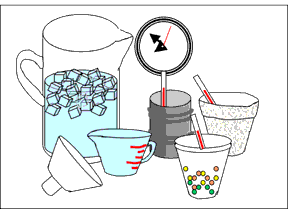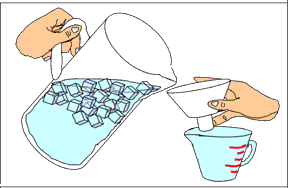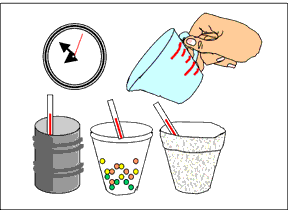 |
 |
|
|
|
|
Contributed by: Council of Chief State School Officers (CCSSO/SCASS) Description:Students test paper cups, styrofoam cups, and metal cans, to determine which type of container would be best to use to keep drinks cool on a hot day. One of each of the three types of containers is filled with ice water and a thermometer placed in each. Students are asked to record the temperature in each container after 30 seconds and again after 15 minutes. The total difference in temperature for each type of container is then determined and recorded. The students write their answer to Question #1 while they wait during the 15 minute interval, then answer Question 2 & 3 after taking the second temperature readings. This task is designed to take students approximately 40-50 minutes to complete.
Overall Task Content Area:
Specific Knowledge Areas:
Performance Expectations:
National Science Education Standards: 4 B PS 1: Properties of objects and materials: Grades
K-4 1.2 Objects are made of one or more materials, such as paper, wood and metal. Objects can be described by the properties of the materials from which they are made, and those properties can be used to separate or sort a group of objects or materials. 4 A SI 1: Ability to do scientific inquiry: Grades K-4
1.3 Employ simple equipment and tools to gather data and extend the senses. In early years, students develop simple skills, such as how to observe, measure, cut, connect, switch, turn on and off, pour, hold, tie, and hook. Beginning with simple instruments, students can use rulers to measure the length, height, and depth of objects and materials; thermometers to measure temperature; watches to measure time; beam balances and spring scales to measure weight and force; magnifiers to observe objects and organisms; and microscopes to observe the finer details of plants, animals, rocks, and other materials. Children also develop skills in the use of computers and calculators for conducting investigations. 1.4 Use data to construct a reasonable explanation. This aspect of the standard emphasizes the studentsí thinking as they use data to formulate explanations. Even at the earliest grade levels, students should learn what constitutes evidence and judge the merits or strength of the data and information that will be used to make explanations. After students propose an explanation, they will appeal to the knowledge and evidence they obtained to support their explanations. Students should check their explanations against scientific knowledge, experiences, and observations of others. 4 B PS 3: Light, heat, electricity, and magnetism
(Use the "hot" link on the PALS home page to check the full text of related National Science Education Standards, if desired.)
DAP1: Formulate questions that can
be addressed with data and collect, organize, and display relevant
data to answer them: MEAS1: Understand measurable attributes of objects and
the units, systems, and processes of measurement: MEAS2: Apply appropriate techniques, tools, and formulas
to determine measurements: RP3: Develop and evaluate mathematical arguments and
proofs:
This task is designed to take students approximately 40-50 minutes to complete. Students will be working in groups of 4-6 for the experiment/activity part of this exercise. Each student must record the information in his or her own booklet (test papers). Allow from 20 to 25 minutes to complete the group work, and a similar time period for students to do their individual answers to the test questions. Be sure to have the students strain any ice out of the water when they put it into the cups. If ice is present the temperature will not change significantly until the ice completely melts. Students should be ready to work as soon as the period begins. Group assignments should be made in advance. The materials should be set out at each lab station, if possible. A central supply area, if needed, should be accessible. All supplies should be clearly labeled.
At this station students should have:
Group assignments should be made in advance. To be sure that the accuracy of the thermometers is not a major variable, lay out all of the thermometers for a few minutes. Then, choose three thermometers that have temperature readings that are nearly the same for each student station.
Safety:
Extensions/modifications:
Advanced Preparation Set Up:
|


